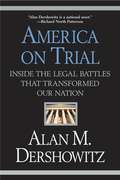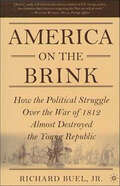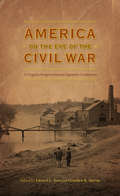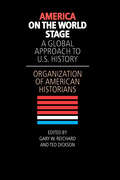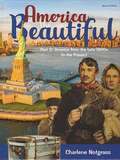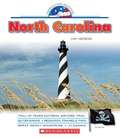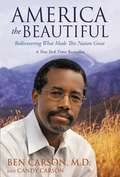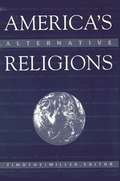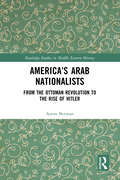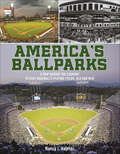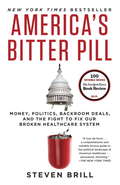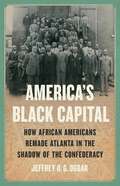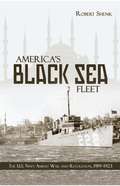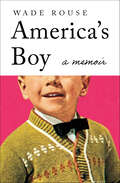- Table View
- List View
America on Fire: The Untold History Of Police Violence And Black Rebellion Since The 1960s
by Elizabeth HintonFrom one of our top historians, a groundbreaking story of policing and “riots” that shatters our understanding of the post–civil rights era. <P><P> What began in spring 2020 as local protests in response to the killing of George Floyd by Minneapolis police quickly exploded into a massive nationwide movement. Millions of mostly young people defiantly flooded into the nation’s streets, demanding an end to police brutality and to the broader, systemic repression of Black people and other people of color. To many observers, the protests appeared to be without precedent in their scale and persistence. Yet, as the acclaimed historian Elizabeth Hinton demonstrates in America on Fire, the events of 2020 had clear precursors—and any attempt to understand our current crisis requires a reckoning with the recent past. <P><P>Even in the aftermath of Donald Trump, many Americans consider the decades since the civil rights movement in the mid-1960s as a story of progress toward greater inclusiveness and equality. Hinton’s sweeping narrative uncovers an altogether different history, taking us on a troubling journey from Detroit in 1967 and Miami in 1980 to Los Angeles in 1992 and beyond to chart the persistence of structural racism and one of its primary consequences, the so-called urban riot. Hinton offers a critical corrective: the word riot was nothing less than a racist trope applied to events that can only be properly understood as rebellions—explosions of collective resistance to an unequal and violent order. As she suggests, if rebellion and the conditions that precipitated it never disappeared, the optimistic story of a post–Jim Crow United States no longer holds. <P><P>Black rebellion, America on Fire powerfully illustrates, was born in response to poverty and exclusion, but most immediately in reaction to police violence. In 1968, President Lyndon Johnson launched the “War on Crime,” sending militarized police forces into impoverished Black neighborhoods. Facing increasing surveillance and brutality, residents threw rocks and Molotov cocktails at officers, plundered local businesses, and vandalized exploitative institutions. Hinton draws on exclusive sources to uncover a previously hidden geography of violence in smaller American cities, from York, Pennsylvania, to Cairo, Illinois, to Stockton, California. <P><P>The central lesson from these eruptions—that police violence invariably leads to community violence—continues to escape policymakers, who respond by further criminalizing entire groups instead of addressing underlying socioeconomic causes. The results are the hugely expanded policing and prison regimes that shape the lives of so many Americans today. Presenting a new framework for understanding our nation’s enduring strife, America on Fire is also a warning: rebellions will surely continue unless police are no longer called on to manage the consequences of dismal conditions beyond their control, and until an oppressive system is finally remade on the principles of justice and equality.
America on Trial: Inside the Legal Battles That Transformed Our Nation
by Alan M. DershowitzOne might wonder how the trial of Mike Tyson or Lizzie Borden "transformed our nation" as opposed to other cases included by Dershowitz (law, Harvard U.), such as the Brown vs. Board of Education or Bush vs. Gore, but the reasoning behind the selection becomes clearer when he notes that the "basic criterion is passion" (i.e. a reflection of the passion of the times, arousing the passion of Americans, etc.). Basing his narratives of 64 American trials on the actual transcripts from the courtroom, he describes such cases as the trials of John Peter Zenger, Aaron Burr, Sacco and Vanzetti, Leopold and Loeb, the Rosenbergs, American Indian Movement activists, Bernhard Goetz, and John DeLorean. Annotation ©2004 Book News, Inc., Portland, OR (booknews.com)
America on the Brink: How the Political Struggle Over the War of 1812 Almost Destroyed the Young Republic
by Richard Buel Jr.The fascinating story of how New England Federalists threatened to dissolve the Union by making a separate peace with England during the War of 1812. Many people would be surprised to learn that the struggle between Thomas Jefferson's Republican Party and Alexander Hamilton's Federalist Party defined--and jeopardized--the political life of the early American republic. Richard Buel Jr.'s America on the Brink looks at why the Federalists, who worked so hard to consolidate the federal government before 1800, went to great lengths to subvert it after Jefferson's election. In addition to taking the side of the British in the diplomatic dance before the war, the Federalists did everything they could to impede the prosecution of the war, even threatening the Madison Administration with a separate peace for New England in 1814. Readers fascinated by the world of the Founding Fathers will come away from this riveting account with a new appreciation for how close the new nation came to falling apart almost fifty years before the Civil War.
America on the Eve of the Civil War
by Edward L. Ayers Carolyn R. Martin"This remarkable publication provides a captivating and brilliantly executed series of conversations among seventeen most impressive historians. These participants in a daylong conference focusing on the extraordinary years leading to the Civil War provide an incredible range of historical information that is both educational and exciting. Here is an opportunity to draw on a lively exchange between a substantial number of knowledgeable and entertaining scholars."--James Oliver Horton, author of Landmarks of African American History
America on the World Stage: A Global Approach to U.S. History
by Organization of American HistoriansRecognizing the urgent need for students to understand the emergence of the United States' power and prestige in relation to world events, Gary W. Reichard and Ted Dickson reframe the teaching of American history in a global context. Each essay covers a specific chronological period and approaches fundamental topics and events in United States history from an international perspective, emphasizing how the development of the United States has always depended on its transactions with other nations for commodities, cultural values, and populations. For each historical period, the authors also provide practical guidance on bringing this international approach to the classroom, with suggested lesson plans and activities. Ranging from the colonial period to the civil rights era and everywhere in between, this collection will help prepare Americans for success in an era of global competition and collaboration. Contributors are David Armitage, Stephen Aron, Edward L. Ayers, Thomas Bender, Stuart M. Blumin, J. D. Bowers, Orville Vernon Burton, Lawrence Charap, Jonathan Chu, Kathleen Dalton, Betty A. Dessants, Ted Dickson, Kevin Gaines, Fred Jordan, Melvyn P. Leffler, Louisa Bond Moffitt, Philip D. Morgan, Mark A. Noll, Gary W. Reichard, Daniel T. Rodgers, Leila J. Rupp, Brenda Santos, Gloria Sesso, Carole Shammas, Suzanne M. Sinke, Omar Valerio-Jimenez, Penny M. Von Eschen, Patrick Wolfe, and Pingchao Zhu.
America the Beautiful Part 1: America from 1000 to 1877
by Charlene NotgrassAmerica the Beautiful, collated in a chronological order, is a package where we learn about America in thirty units. Lessons include: Our American Story; God's Wonders; An American Landmark; An American Biography; Daily Life. The author of the book ensures that readers learn about God in the making of America.
America the Beautiful Part 1: America from 1000 to 1877
by Charlene NotgrassAmerica the Beautiful by Charlene Notgrass is a one-year American history, geography, and literature course designed for students in grades 5-8. It combines the flexibility and richness of a unit study with the simplicity of a textbook-based approach to history. Daily lessons guide your child chronologically through American history, highlighting key events, people, and places. This book has 75 lessons beginning with life in America before Europeans came and continuing through the first years after the Civil War.
America the Beautiful Part 2: America from 1800s to the Present
by Charlene NotgrassThis book is a continuation of America the Beautiful Part 1 in telling the American Story.
America the Beautiful Part 2: America from the Late 1800s to the Present
by Charlene NotgrassThis book has 75 lessons beginning with the late 1800s and continuing to modern times.
America the Beautiful: Montana
by R. Conrad SteinMontana is one of the nations largest states, but it is home to very few large towns or cities. Rather, it is defined by its vast wilderness areas, which range from the high peaks of the Rocky Mountains to the rolling hills and flatlands of the Great Plains. Readers will find out how Montana was settled and what role it has played in U.S. history. They will also explore the states rich culture and traditions.
America the Beautiful: North Carolina
by Ann HeinrichsNorth Carolina Is A Place Of Varied Landscapes. Its mountains are among the tallest and most rugged east of the Mississippi River, and its coastal plains are low and flat. High in the western mountains rises Mount Mitchell. At 6,684 feet (2,037 meters), it's the state's highest point. Hundreds of miles to the east, the land drops down to sea level along the Atlantic coast.
America the Beautiful: Rediscovering What Made This Nation Great
by Ben Carson Candy CarsonWhat is America becoming? Or, more importantly, what can she be if we reclaim a vision for the things that made her great in the first place? In America the Beautiful, Dr. Ben Carson helps us learn from our past in order to chart a better course for our future. From his personal ascent from inner-city poverty to international medical and humanitarian acclaim, Carson shares experiential insights that help us understand. . . what is good about America. . . where we have gone astray. . . which fundamental beliefs have guided America from her founding into preeminence among nations. Written by a man who has experienced America's best and worst firsthand, America the Beautiful is at once alarming, convicting, and inspiring. You'll gain new perspectives on our nation's origins, our Judeo-Christian heritage, our educational system, capitalism versus socialism, our moral fabric, healthcare, and much more. An incisive manifesto of the values that shaped America's past and must shape her future, America the Beautiful calls us all to use our God-given talents to improve our lives, our communities, our nation, and our world.
America the Ingenious: How a Nation of Dreamers, Immigrants, and Tinkerers Changed the World
by Kevin Baker“Among the many rewards of America the Ingenious, Kevin Baker’s survey of Yankee know-how, is stumbling on its buried nuggets. . . . Baker examines a wide range of the achievements that have made, and still make, America great again—and again.” —The Wall Street Journal All made in America: The skyscraper and subway car. The telephone and telegraph. The safety elevator and safety pin. Plus the microprocessor, amusement park, MRI, supermarket, Pennsylvania rifle, and Tennessee Valley Authority. Not to mention the city of Chicago or jazz or that magnificent Golden Gate Bridge. What is it about America that makes it a nation of inventors, tinkerers, researchers, and adventurers—obsessive pursuers of the never-before-created? And, equally, what is it that makes America such a fertile place to explore, discover, and launch the next big thing? In America the Ingenious, bestselling author Kevin Baker brings his gift of storytelling and eye for historical detail to the grand, and grandly entertaining, tale of American innovation. Here are the Edisons and Bells and Carnegies, and the stories of how they followed their passions and changed our world. And also the less celebrated, like Jacob Youphes and Loeb Strauss, two Jewish immigrants from Germany who transformed the way at least half the world now dresses (hint: Levi Strauss). And Leo Fender, who couldn’t play a note of music, midwifing rock ’n’ roll through his solid-body electric guitar and amplifier. And the many women who weren’t legally recognized as inventors, but who created things to make their lives easier that we use every day—like Josephine Cochran, inventor of the dishwasher, or Marion O’Brien Donovan, who invented a waterproof diaper cover. Or a guy with the improbable name of Philo Farnsworth, who, with his invention of television, upended communication as significantly as Gutenberg did. At a time when America struggles with different visions of what it wants to be, America the Ingenious shows the extraordinary power of what works: how immigration leads to innovation, what a strong government and strong public education mean to a climate of positive practical change, and why taking the long view instead of looking for short-term gain pays off many times over, not only for investors and inventors, but for the rest of us whose lives are made better by the new. America and its nation of immigrants have excelled at taking ideas from anywhere and transforming them into the startling, often unexpectedly beautiful creations that have shaped our world. This is that story.
America the Philosophical
by Carlin RomanoA bold, insightful book that rejects the myth of America the Unphilosophical, arguing that America today towers as the most philosophical culture in the history of the world, an unprecedented marketplace of truth and argument that far surpasses ancient Greece or any other place one can name. With verve and keen intelligence, Carlin Romano--Pulitzer Prize finalist, award-winning book critic, and professor of philosophy--takes on the widely held belief that ours is an anti-intellectual society. Instead, while providing a richly reported overview of American thought, Romano argues that ordinary Americans see through phony philosophical justifications faster than anyone else, and that the best of our thinkers abandon artificial academic debates for fresh intellectual enterprises, such as cyberphilosophy. Along the way, Romano seeks to topple philosophy's most fiercely admired hero, Socrates, asserting that it is Isocrates, the nearly forgotten Greek philosopher who rejected certainty, whom Americans should honor as their intellectual ancestor. America the Philosophical introduces readers to a nation whose existence most still doubt: a dynamic, deeply stimulating network of people and places drawn together by shared excitement about ideas. From the annual conference of the American Philosophical Association, where scholars tack wiseguy notes addressed to Spinoza on a public bulletin board, to the eruption of philosophy blogs where participants discuss everything from pedagogy to the philosophy of science to the nature of agency and free will, Romano reveals a world where public debate and intellectual engagement never stop. And readers meet the men and women whose ideas have helped shape American life over the previous few centuries, from well-known historical figures like William James and Ralph Waldo Emerson, to modern cultural critics who deserve to be seen as thinkers (Kenneth Burke, Edward Said), to the iconoclastic African American, women, Native American, and gay mavericks (Cornel West, Susan Sontag, Anne Waters, Richard Mohr) who have broadened the boundaries of American philosophy. Smart and provocative, America the Philosophical is a rebellious tour de force that both celebrates our country's unparalleled intellectual energy and promises to bury some of our most hidebound cultural clichés.
America's Alternative Religions (SUNY Series in Religious Studies)
by Timothy MillerThis is a single-volume source of reliable information on the most important alternative religions, covering for each such essentials as history, theology, impact on the culture, and current status. The chapters of the book were written by experts who study the movements they have written about.
America's Arab Nationalists: From the Ottoman Revolution to the Rise of Hitler (Routledge Studies in Middle Eastern History)
by Aaron BermanAmerica’s Arab Nationalists focuses in on the relationship between Arab nationalists and Americans in the struggle for independence in an era when idealistic Americans could see the Arab nationalist struggle as an expression of their own values. In the first three decades of the twentieth century (from the 1908 Ottoman revolution to the rise of Hitler), important and influential Americans, including members of the small Arab-American community, intellectually, politically and financially participated in the construction of Arab nationalism. This book tells the story of a diverse group of people whose contributions are largely unknown to the American public. The role Americans played in the development of Arab nationalism has been largely unexplored by historians, making this an important and original contribution to scholarship. This volume is of great interest to students and academics in the field, though the narrative style is accessible to anoyone interested in Arab nationalism, the conflict between Zionists and Palestinians, and the United States’ relationship with the Arab world.
America's Assembly Line
by David E. NyeFrom the Model T to today's "lean manufacturing": the assembly line as crucial, yet controversial, agent of social and economic transformation.The mechanized assembly line was invented in 1913 and has been in continuous operation ever since. It is the most familiar form of mass production. Both praised as a boon to workers and condemned for exploiting them, it has been celebrated and satirized. (We can still picture Chaplin's little tramp trying to keep up with a factory conveyor belt.) In America's Assembly Line, David Nye examines the industrial innovation that made the United States productive and wealthy in the twentieth century.The assembly line—developed at the Ford Motor Company in 1913 for the mass production of Model Ts—first created and then served an expanding mass market. It also transformed industrial labor. By 1980, Japan had reinvented the assembly line as a system of “lean manufacturing”; American industry reluctantly adopted the new approach. Nye describes this evolution and the new global landscape of increasingly automated factories, with fewer industrial jobs in America and questionable working conditions in developing countries. A century after Ford's pioneering innovation, the assembly line continues to evolve toward more sustainable manufacturing.
America's Ballparks: A Trip Across the Country to Visit Baseball’s Playing Fields, Old and New
by Nancy J. HajeskiNothing stirs the soul of a baseball fan like the crack of a bat against a ball . . . or the sight of a fielder leaping high into the air to snatch that ball out of play. What would these fans be without their favorite sport, and what would baseball be without those high-tiered, impossibly beautiful temples to the sport called ballparks? North Americans have treasured some wonderful venues from bygone eras, but sadly lost so many as well. Within the pages of this book readers can revel in the new builds—the retro-modern fields inspired by Baltimore&’s Camden Yards, while looking fondly back at the older, more traditional ballparks often referred to as Jewel Boxes. In America&’s Ballparks all 30 Major League Baseball stadiums are covered in detail, along with a brief history of their teams and background on any previous ballparks in which they played. Special features throughout the book include: • the design evolution and anatomy of ballparks • the home fields of the Negro Leagues • the top venues of Japan&’s Nippon Professional Baseball. • There is even a section that examines the long partnership between baseball and corporate branding. • Each ballpark entry provides cumulative team stats, as well as lists of stadium firsts and club achievements.
America's Bank
by Roger LowensteinA tour de force of historical reportage, America's Bank illuminates the tumultuous era and remarkable personalities that spurred the unlikely birth of America's modern central bank, the Federal Reserve. Today, the Fed is the bedrock of the financial landscape, yet the fight to create it was so protracted and divisive that it seems a small miracle that it was ever established. For nearly a century, America, alone among developed nations, refused to consider any central or organizing agency in its financial system. Americans' mistrust of big government and of big banks--a legacy of the country's Jeffersonian, small-government traditions--was so widespread that modernizing reform was deemed impossible. Each bank was left to stand on its own, with no central reserve or lender of last resort. The real-world consequences of this chaotic and provincial system were frequent financial panics, bank runs, money shortages, and depressions. By the first decade of the twentieth century, it had become plain that the outmoded banking system was ill equipped to finance America's burgeoning industry. But political will for reform was lacking. It took an economic meltdown, a high-level tour of Europe, and--improbably--a conspiratorial effort by vilified captains of Wall Street to overcome popular resistance. Finally, in 1913, Congress conceived a federalist and quintessentially American solution to the conflict that had divided bankers, farmers, populists, and ordinary Americans, and enacted the landmark Federal Reserve Act.Roger Lowenstein--acclaimed financial journalist and bestselling author of When Genius Failed and The End of Wall Street--tells the drama-laden story of how America created the Federal Reserve, thereby taking its first steps onto the world stage as a global financial power. America's Bank showcases Lowenstein at his very finest: illuminating complex financial and political issues with striking clarity, infusing the debates of our past with all the gripping immediacy of today, and painting unforgettable portraits of Gilded Age bankers, presidents, and politicians.Lowenstein focuses on the four men at the heart of the struggle to create the Federal Reserve. These were Paul Warburg, a refined, German-born financier, recently relocated to New York, who was horrified by the primitive condition of America's finances; Rhode Island's Nelson W. Aldrich, the reigning power broker in the U.S. Senate and an archetypal Gilded Age legislator; Carter Glass, the ambitious, if then little-known, Virginia congressman who chaired the House Banking Committee at a crucial moment of political transition; and President Woodrow Wilson, the academician-turned-progressive-politician who forced Glass to reconcile his deep-seated differences with bankers and accept the principle (anathema to southern Democrats) of federal control. Weaving together a raucous era in American politics with a storied financial crisis and intrigue at the highest levels of Washington and Wall Street, Lowenstein brings the beginnings of one of the country's most crucial institutions to vivid and unforgettable life. Readers of this gripping historical narrative will wonder whether they're reading about one hundred years ago or the still-seething conflicts that mark our discussions of banking and politics today. From the Hardcover edition.
America's Bank: The Epic Struggle to Create the Federal Reserve
by Roger LowensteinA tour de force of historical reportage, America's Bank illuminates the tumultuous era and remarkable personalities that spurred the unlikely birth of America's modern central bank, the Federal Reserve. Today, the Fed is the bedrock of the financial landscape, yet the fight to create it was so protracted and divisive that it seems a small miracle that it was ever established. For nearly a century, America, alone among developed nations, refused to consider any central or organizing agency in its financial system. Americans' mistrust of big government and of big banks--a legacy of the country's Jeffersonian, small-government traditions--was so widespread that modernizing reform was deemed impossible. Each bank was left to stand on its own, with no central reserve or lender of last resort. The real-world consequences of this chaotic and provincial system were frequent financial panics, bank runs, money shortages, and depressions. By the first decade of the twentieth century, it had become plain that the outmoded banking system was ill equipped to finance America's burgeoning industry. But political will for reform was lacking. It took an economic meltdown, a high-level tour of Europe, and--improbably--a conspiratorial effort by vilified captains of Wall Street to overcome popular resistance. Finally, in 1913, Congress conceived a federalist and quintessentially American solution to the conflict that had divided bankers, farmers, populists, and ordinary Americans, and enacted the landmark Federal Reserve Act.Roger Lowenstein--acclaimed financial journalist and bestselling author of When Genius Failed and The End of Wall Street--tells the drama-laden story of how America created the Federal Reserve, thereby taking its first steps onto the world stage as a global financial power. America's Bank showcases Lowenstein at his very finest: illuminating complex financial and political issues with striking clarity, infusing the debates of our past with all the gripping immediacy of today, and painting unforgettable portraits of Gilded Age bankers, presidents, and politicians.Lowenstein focuses on the four men at the heart of the struggle to create the Federal Reserve. These were Paul Warburg, a refined, German-born financier, recently relocated to New York, who was horrified by the primitive condition of America's finances; Rhode Island's Nelson W. Aldrich, the reigning power broker in the U.S. Senate and an archetypal Gilded Age legislator; Carter Glass, the ambitious, if then little-known, Virginia congressman who chaired the House Banking Committee at a crucial moment of political transition; and President Woodrow Wilson, the academician-turned-progressive-politician who forced Glass to reconcile his deep-seated differences with bankers and accept the principle (anathema to southern Democrats) of federal control. Weaving together a raucous era in American politics with a storied financial crisis and intrigue at the highest levels of Washington and Wall Street, Lowenstein brings the beginnings of one of the country's most crucial institutions to vivid and unforgettable life. Readers of this gripping historical narrative will wonder whether they're reading about one hundred years ago or the still-seething conflicts that mark our discussions of banking and politics today. From the Hardcover edition.
America's Bitter Pill: Money, Politics, Backroom Deals, and the Fight to Fix Our Broken Healthcare System
by Steven BrillAmerica's Bitter Pill is Steven Brill's much-anticipated, sweeping narrative of how the Affordable Care Act, or Obamacare, was written, how it is being implemented, and, most important, how it is changing--and failing to change--the rampant abuses in the healthcare industry. Brill probed the depths of our nation's healthcare crisis in his trailblazing Time magazine Special Report, which won the 2014 National Magazine Award for Public Interest. Now he broadens his lens and delves deeper, pulling no punches and taking no prisoners. It's a fly-on-the-wall account of the fight, amid an onslaught of lobbying, to pass a 961-page law aimed at fixing America's largest, most dysfunctional industry--an industry larger than the entire economy of France. It's a penetrating chronicle of how the profiteering that Brill first identified in his Time cover story continues, despite Obamacare. And it is the first complete, inside account of how President Obama persevered to push through the law, but then failed to deal with the staff incompetence and turf wars that crippled its implementation. Brill questions all the participants in the drama, including the president, to find out what happened and why. He asks the head of the agency in charge of the Obamacare website how and why it crashed. And he tells the cliffhanger story of the tech wizards who swooped in to rebuild it. Brill gets drug lobbyists to open up on the deals they struck to protect their profits in return for supporting the law. And he buttresses all these accounts with meticulous research and access to internal memos, emails, notes, and journals written by the key players during all the pivotal moments. Brill is there with patients when they are denied cancer care at a hospital, or charged $77 for a box of gauze pads. Then he asks the multimillion-dollar executives who run the hospitals to explain why. He even confronts the chief executive of America's largest health insurance company and asks him to explain an incomprehensible Explanation of Benefits his company sent to Brill. And he's there as a group of young entrepreneurs gamble millions to use Obamacare to start a hip insurance company in New York's Silicon Alley. Vividly capturing what he calls the "milestone" achievement of Obamacare, Brill introduces us to patients whose bank accounts or lives have been saved by the new law--although, as he explains, that is only because Obamacare provides government subsidies for "tens of millions of new customers" to pay the same exorbitant prices that were the problem in the first place. All that is weaved together in an elegantly crafted, fast-paced narrative. But by chance America's Bitter Pill ends up being much more--because as Brill was completing this book, he had to undergo urgent open-heart surgery. Thus, this also becomes the story of how one patient who thinks he knows everything about healthcare "policy" rethinks it from a hospital gurney--and combines that insight with his brilliant reporting. The result: a surprising new vision of how we can fix American healthcare so that it stops draining the bank accounts of our families and our businesses, and the federal treasury.From the Hardcover edition.
America's Black Capital: How African Americans Remade Atlanta in the Shadow of the Confederacy
by Jeffrey O. OgbarThe remarkable story of how African Americans transformed Atlanta, the former heart of the Confederacy, into today&’s Black mecca Atlanta is home to some of America&’s most prominent Black politicians, artists, businesses, and HBCUs. Yet, in 1861, Atlanta was a final contender to be the capital of the Confederacy. Sixty years later, long after the Civil War, it was the Ku Klux Klan&’s sacred &“Imperial City.&” America&’s Black Capital chronicles how a center of Black excellence emerged amid virulent expressions of white nationalism, as African Americans pushed back against Confederate ideology to create an extraordinary locus of achievement. What drove them, historian Jeffrey O. G. Ogbar shows, was the belief that Black uplift would be best advanced by forging Black institutions. America&’s Black Capital is an inspiring story of Black achievement against all odds, with effects that reached far beyond Georgia, shaping the nation&’s popular culture, public policy, and politics.
America's Black Founders: Revolutionary Heroes & Early Leaders with 21 Activities
by Nancy SandersCelebrating the lesser known but significant lives and contributions of our nation's early African American leaders, this multicultural complement to most children's books on the American Revolution covers a wide spectrum of subjects, including military, art, religion, and science. Weaving the histories of dozens of men and women--soldiers, sailors, ministers, poets, merchants, doctors, and other community leaders--to properly recognize them among the founders of the United States of America, this text gives a better sense of what these individuals accomplished and the times in which they lived. Activities include celebrating Constitution Day, cooking colonial foods, publishing a newspaper, petitioning their government, and more. This valuable resource also includes a time line of significant events, a list of historic sites to visit or explore online, and Web resources for further study.
America's Black Sea Fleet
by Robert ShenkIn a high-tempo series of operations throughout the Black Sea, Aegean Sea and eastern Mediterranean, a small American fleet of destroyers and other naval vessels responded ably to several major international crises including the last days of the Russian Revolution and the 1920-1922 Turkish Nationalist Revolution. Officers and men of the navy's "four-piper" destroyers began by investigating circumstances on the ground in mainland Turkey right after World War I, and by transporting American relief teams to ports throughout Turkey and Southern Russia to aid the tens of thousands of orphans and refugees who had survived the wartime Armenian genocide.Then the destroyers assisted in the final evacuation of 150,000 White Russians from the Crimea to Constantinople (one of the final acts of the Russian Revolution); coordinated the visits of the Hoover grain ships to ports in Southern Russia where millions were enduring a horrendous famine; witnessed and reported on the terrible dolorosa of the Greeks of the Pontus region of Turkey; and, in September of 1922, conducted the evacuation of hundreds of thousands of Greek and Armenian refugees from burning Smyrna. This latter event was the cataclysmic conclusion of the Turkish Nationalist Revolution, which had begun in early 1920.After Smyrna, the destroyers escorted Greek steamers in their rescue of ethnic Christian civilians being expelled from all the ports of Anatolian Turkey. As the conclusion of a long war between Nationalist Turks and an invading Hellenic Greek army, these people were being forced out of their ancestral homes by the Turks. Sometimes American destroyers carried hundreds of such refugees to friendly ports on their own weather decks.Upon the burning of Smyrna in September of 1922, Admiral Mark Bristol's small fleet had grown to some 26 naval vessels, most of them destroyers, although some cruisers, naval repair vessels and supply ships also came, and the battleships Arizona and Utah also appeared briefly. It was during 1922 that the destroyer Bainbridge rescued 482 of 495 men, women and children from the burning French transport Vinh Long in the Sea of Marmora. The destroyer accomplished this by the expedient of ramming the large French ship so the exploding ammunition could not continue to force the vessels apart. For this action, Lieut. Commander W. Atlee Edwards was awarded the Medal of Honor by America, and the Legion of Honor by France.Over four years, Admiral Bristol maintained a strong grip on American naval and diplomatic affairs throughout the region. Headquartered at the American Embassy at Constantinople, Bristol also worked to further American business interests in Turkey, and tended to favor Turks over Greeks and Armenians in the process. Many Americans were convinced that Bristol was biased on behalf of the Turks, and a couple of navy captains risked their careers by speaking out about impending Turkish massacres that Bristol wanted to hush up.Several later-famous admirals saw duty in Bristol's small navy, including William Leahy, Thomas Kinkaid, Julian Wheeler, Tip Merrill, Japy Hepburn and Dan Gallery, while statesman Allen Dulles was one of Bristol's key diplomats. Most of these men and most of the sailors, too, enjoyed the terrific nightlife of Constantinople that existed right alongside all the refugee heartbreak. When their duties kept them at sea or alongside grain ships in Russia or moored at the spartan Black Sea ports, the Americans kept their spirits up by racing ships' boats, shooting game, sightseeing, and (especially) by playing baseball. Captain Pratt Mannix even took advantage of his ship's briefly anchoring near the Gallipoli battlefield to become the first American to swim the famous Hellespont
America's Boy: A Memoir
by Wade Rouse&“A revelatory story about acceptance, pride, and the many ways even a seemingly prejudiced family can surprise us&” by the bestselling author of Magic Season (The Washington Post).Indie Next List &“Great Read&” SelectionAmerican Library Association&’s Inaugural &“Rainbow List&” Selection In this memoir, writer and journalist Wade Rouse delivers a humorous and heartwarming account of his Midwestern childhood and coming of age as a gay man. Born in Granby, a small farm town in the southwest Missouri Ozarks, Wade was a fish out of water as long as he could remember—or at least since he participated in his family&’s mock Miss America pageant when he was just five years old, clad in his grandmother&’s red &“whore&” heels and his mother&’s black-and-white polka-dot bikini. Life didn&’t get easier in Wade&’s conservative hometown, especially after his older brother died just a month after Wade graduated junior high school. It was then that Wade buried his brother—and his sexuality, so his parents wouldn&’t mourn the loss of a second son. Finally, after years of a descent into obsessive-compulsive behaviors and overeating, Wade was able to come out to himself, losing weight and gaining confidence until he had nothing left to hide. Filled with memories of happiness and heartbreak, America&’s Boy is both &“a quirky tribute to [Rouse&’s] rural Ozark family, and an easily digestible, homespun tale of a bygone era in Middle America&” (Time Out Chicago).&“A storyteller and a memoirist in the best sense of the words. . . . Reading Rouse&’s memoir is more like sitting with a good friend and a cold beer, trading stories and remembering those things that may have been painful or tragic at the time, but must now be respected for what they are.&” —Metro Weekly

